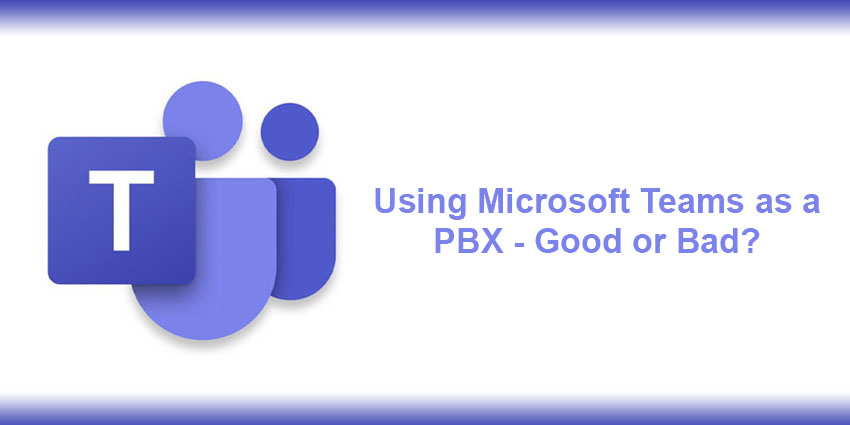A Private Branch Exchange (PBX) lets you build a private telephone network for use within your company or organisation. It can employ a number of telephony technologies including VoIP or PSTN. PBX covers hardware as well as software/interaction systems, essentially referring to any UC component you might use for business telephony.
This begs a critical question for companies looking to up their digital investments – could you use a digital platform with telephony capabilities as a stand-in for a traditional PBX system? How do platforms like Microsoft Teams fare as a PBX replacement?
There are both pros and cons to this argument.
The “Good” of Teams as a PBX: It Unlocks 8 Undeniable Advantages
Over the last few years, Microsoft has significantly upgraded Teams to work as a fully functional communication and collaboration solution, including telephony. In addition to the cloud-based audio calling that you might expect, it integrates with your existing PSTN infrastructure as well. This makes Microsoft Teams suitable for quick 1-on-1 conversations, group discussions that might morph into video calls, external communications with clients/partners, as well as full-fledged contact centre scenarios.
You can either choose Microsoft’s own Phone System, which is a 100% cloud-based calling solution. Or, if you are entrenched in a local carrier ecosystem (or Calling Plans aren’t available in the region where your office is situated), you can use direct routing to integrate Microsoft Teams with PSTN.
This converts the Teams interface into a dial pad that you can use for calling, just like a regular smartphone or handheld audio peripheral.
But is this a good idea? In several scenarios, the answer is a resounding YES.
There are a number of advantages you can unlock by using Microsoft Teams as your PBX system:
- It reduces your hardware dependency – Microsoft Teams is available on a wide variety of devices, from different form factors to different operating systems. You don’t need to invest in additional PBX hardware, and there is no rip-and-replace needed if you are migrating to a new office/region
- You gain from the resilience of the public cloud – This advantage is specific to those using the cloud-based Phone Systems with Teams. As there is no dependence on a local carrier, you enjoy uptime as long as there is an active internet connection. Microsoft also offers SBA as an offline backup system
- You don’t sacrifice any on traditional telephony’s convenience – Microsoft has been careful to retain all the familiar basics of PBX telephony like music on hold, speed dial, automatic routing in contact centres, call forwarding, emergency calls, etc. You could even plug in a low-cost USB phone (which is essentially a handheld device that connects with a PC via USB) to recreate an old-school telephony experience
- You can lower telephony costs significantly – This is among the biggest advantages of using Microsoft Teams as your PBX. The solution leverages the cloud for long-distance telephony within the organisation, eliminating high carrier charges
- You have a single point of support – A traditional PBX landscape relies on multiple vendors, and downtimes can be difficult to resolve. You have various hardware providers looking after peripherals, there is a telecom carrier offering network connectivity, and there might be an internal or external stakeholder providing the device management software. Microsoft Teams replaces all of this with one solution, with a single point of support
- You can keep existing numbers or start afresh – Established business can port their existing numbers over to Microsoft Teams. New/smaller businesses implementing a PBX for the first time can procure a fresh set of phone numbers from Microsoft
- You can leverage Microsoft Teams-certified hardware – Microsoft has a growing catalogue of natively certified hardware, including headsets, speakerphones, desk phones, wall-mounted devices, etc. These come with Teams-specific capabilities for high-productivity telephony
- It keeps your PBX landscape updates at all times – As one of the world’s leading communication service providers, Microsoft will continue to roll out frequent updates for its Teams’ calling capabilities as well as certified hardware. This reduces admin burden for managing devices and pushing upgrades
Companies that have used Microsoft Teams as their PBX systems report a largely positive experience, thanks to the impressive level of mobility that it offers. The ability to consolidate collaboration and telephony under one umbrella subscription is also a compelling advantage. However, Teams might not make sense for every telephony scenario.
Here’s why.
The “Bad”: 3 Factors to Consider
There is a reason why companies using Microsoft productivity tools are yet to fully utilise its telephony capabilities. This hesitation comes down to three constraints you might face when using Microsoft Teams as a PBX replacement:
- You can add up to 300 seats with Business Voice – Microsoft Teams with Business Voice licencing lets you assign unique phone numbers to a maximum of 300 seats/users. This may not be sufficient for large companies or contact centres. If you require greater than 300 numbers you need to move to Enterprise licencing
- The costing is complex – In terms of costs, Teams’ telephony capabilities are included in your license if you already have an E5 plan and need to purchase only an additional Calling Plan at approximately $12 per month per user. However, those with an E1 or E3 license will have to subscribe to the Phone System feature separately, at $8 per month per user, and might have to spend another $4 on conferencing, depending on your region. Add to this the $12 for calling plans, and you have a not-so-cost-effective $24 per month per user billing
- There is a risk of vendor lock-in – First-time PBX users might be putting “all their eggs in one basket,” as it were. It might be difficult to migrate away from an end-to-end Microsoft-driven communication ecosystem, when your hardware, software, and network connectivity is fully reliant on their service
Microsoft Teams as PBX has a lot going for it, but you simply cannot avoid the cons mentioned. For companies with less than 300 seat requirements, it can be a smart alternative, but Microsoft still has some distance to go before becoming the industry’s PBX provider of choice.







